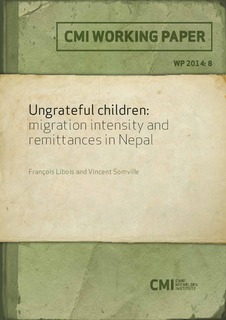Ungrateful children: migration intensity and remittances in Nepal
Working paper
Permanent lenke
http://hdl.handle.net/11250/2475154Utgivelsesdato
2014-07-01Metadata
Vis full innførselSamlinger
- Publications [1497]
Originalversjon
Bergen: Chr. Michelsen Institute (CMI Working Paper WP 2014:8) 25 p.Sammendrag
Poverty has declined dramatically in Nepal since the end of the conflict. The sharp increase in revenues primarily comes from remittances. From a household’s perspective, choosing the appropriate number of migrants is crucial: they must trade-off the direct cost and loss of local income earners versus the potential remittances. We build a standard game theory model of remittances to emphasize two effects of the number of migrants on the total remittances received that go in opposite directions. On one hand, if each migrants earns more than when he stays home, then there is more to remit, and we expect higher total remittances. On the other hand, when there are more migrants, the incentive to free ride also increases: each of them remits less and the total remittances could decrease. We use the last nationally representative survey to test our theoretical predictions. We find that the total remittances received (per household member) in fact substantially decreases with the number of migrants, in line with the free-riding argument. We use past conflict intensity in the district to predict current number of migrants and clear our estimates of endogeneity biases. We also discuss the plausibility of alternative explanations.
